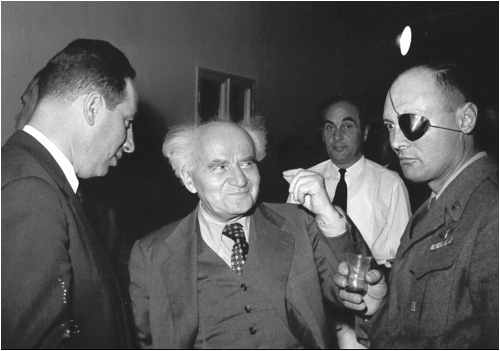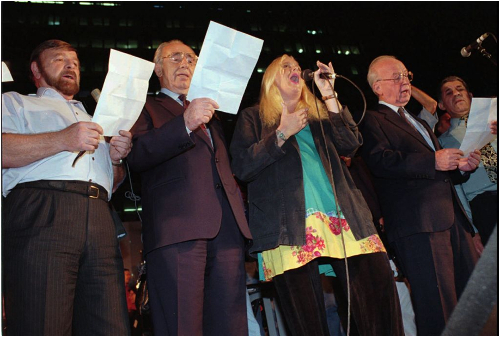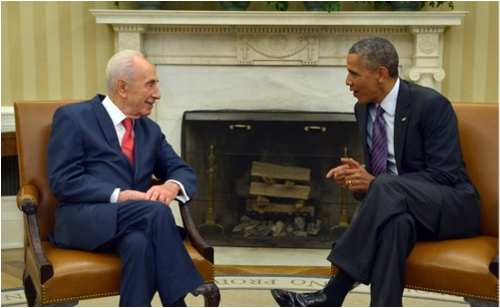As we say goodbye to him, it feels as if Shimon Peres, the last giant of the founding generation, has always been with us. Everyone and his Shimon Peres.
My initial image of Peres when I came to Israel in 1963 to live on a kibbutz was that he was one of Ben-Gurion’s “young Turks”, together with Moshe Dayan. Dayan, the swashbuckling native born tzabar, the charismatic general and former Chief of Staff of the IDF was the more prominent one, and Peres was his party-hack sidekick. I knew that he was the Deputy Defense Minister – Ben-Gurion was both Prime Minister and Defense Minister – and that he had a major role in building the IDF and the Israeli arms industry. It was not yet public knowledge that he was one of the primary architects of the Israeli nuclear program, given the fact that Israel is assumed to have only achieved a full nuclear weapons potential in 1966, and even that remained secret. Later I was to learn that behind the scenes, Ben-Gurion, Peres and Dayan had overcome the opposition to the nuclear program of such figures as Yitzhak Rabin and Yigal Alon, who believed that Israel should rely on its conventional strength alone.
Perhaps one of the reason for Dayan’s prominence was precisely because he had the aura of a tzabar, the second born son of the first kibbutz, Degania, who grew up on the first moshav, Nahalal, who had already joined the underground Haganah fighting force as early as 1938 where he lost his eye. Peres did not fight in the pre-state struggle or in 1948, and always seemed not quite from here like his contemporaries Dayan, Alon and Rabin. He later was to tell writer Aharon Appelfeld, who shared an Eastern European birth place, that he had always aspired to be a tzabar, like his fellow student at the Ben-Shemen Youth Village, Moshe Tehilmzeigger, who joined the underground Palmach and reinvented himself as writer Dan Ben-Amotz, the ultimate tzabar. Yet unlike another Israeli political figure who was not quite from here, Abba Eban, he knew how to build a political base.
A hawk within the labor movement
Peres appeared to be a hawk within the labor movement establishment, always focusing on security. The image of Peres as a hawk was strengthened by the fact that he left Mapai, the forerunner of the Labor Party, in 1965 together with Ben-Gurion, Dayan, Chaim Herzog and others, to form the hawkish Rafi Party. And on the eve of the Six Day War, Peres, together with Menachem Begin, head of the opposition Herut Party (forerunner of the Likud), forced Prime Minister Levi Eshkol to accept Dayan as Defense Minister in a National Unity Government.

Peres, Ben-Gurion and Dayan with the establishment of Rafi (Photo: The Jerusalem Post)
In 1967, after the Six Day War ended, Peres did not join the Movement for Greater Israel, which advocated annexation of all the newly occupied territories in the West Bank and Gaza, like Mapai literary stalwart Natan Alterman and others, though he tended to have sympathy for the new settlers. Settlers Benny Katzover and Yehuda Etzioni both noted in their appreciations for Peres that as Defense Minister in Yitzhak Rabin’s post-Yom Kippur War government, he was instrumental in enabling some of the first illegal settlements to take root. This was unlike Rabin, who had no qualms saying in the early 70s that he would have no problem “visiting Gush Etzion with a visa”. Later in life Peres eventually appeared to express regret for the role he played in the start of the settlement enterprise.
Admiring U.S. President James K. Polk
The first time I saw Peres in person was at the annual meeting of the Association of American and Canadian Immigrants (AACI) around 1968/69. At the time, he declared that “you should be proud of your great President James K. Polk, who should serve as an inspiration to us all.” The audience, most American immigrants at the time were graduates of left-wing Zionist youth movements, could barely contain themselves from laughing. James K. Polk? Then it became clear that Peres saw a parallel between the Six Day War and the Mexican-American War led by Polk and the eventual annexation of Texas and the whole Southwest.
It took another 20 years for Peres to begin to internalize the post-1967 views of his mentor Ben-Gurion, who believed that all of the territories occupied by Israel in the war (except for Jerusalem and the Golan Heights) should be evacuated. The turning point was the First Intifada, which began in 1987. As Foreign Minister at the time in another National Unity Government, Peres had tried to achieve an agreement with King Hussein of Jordan to take responsibility for the West Bank, but this initiative was vetoed by Likud Prime Minister Yitzhak Shamir.
A well-earned Nobel Peace Prize
That’s when Peres finally made the transition to the dove that he was to become in the next and final chapters of his life, the dove who was eulogized so eloquently at his funeral by President Obama, by Bill Clinton, by Tony Blair and so many other international leaders, as the symbol of a peace-seeking Israel based upon the internationally accepted formula for a two-state solution as the key to Israeli-Palestinian peace and the future peace and security of the Israeli people.
In 1992, as Foreign Minister in the Rabin government, Peres had the courage to allow his Deputy Foreign Minister Dr.Yossi Beilin to oversee the initial stages of dialogue between academics Dr. Ron Pundak and Dr. Yair Hirshfeld in Oslo with their Palestinian interlocutors, which eventually led to the breakthrough signing of the Oslo Accords, the Declaration of Principles between the State of Israel and the PLO in 1993, followed by the peace treaty between Jordan and Israel in 1994.
By that time, the Nobel Peace Prize that Peres received in 1994, together with Rabin and Yasser Arafat, was richly deserved. He had clearly become a man of peace, whose vision of a “New Middle East” was an inspiration to many.

Yasser Arafat, Shimon Peres and Yitzhak Rabin receiving the Nobel Peace Prize (Photo: Wikipedia).
Then came that deadly, fateful night on November 4th, 1995, when Peres stood alongside Rabin at the end of the rally for peace and against violence, singing Shir La’Shalom (The Song to Peace). We all know what happened next. At the end of the rally, Yigal Amir was lurking at the bottom of the stairs. Peres came down first, and he could have shot him, but he decided to wait for Rabin, who he felt was the key to stopping the peace process.

Singing “The Song to Peace” together with Rabin and singer Miri Aloni, a few minutes before the shots were fired. (Photo: Times of Israel)
Two critical mistakes
Peres became prime minister, and then proceeded to make two of the most critical mistakes of his political career. He should have called immediate elections, he would have won by a landslide, and would have been able to continue the process that had begun at Oslo, possibly enabling the achievement of a final status agreement within the 5 year agreed upon time-frame. Instead, he wanted to win the elections based on his own record, and waited six months before they were held. The second mistake was sanctioning the assassination of Hamas operative Yahya Ayash (known as “The Engineer”) in Gaza, to shore up his security credentials. Ayash had stopped being active, and was no longer a danger, but when the security officials said there was “an opportunity” to hit him, he opted to give the green light. This led Hamas to carry out a series of deadly suicide bombing attacks against Israeli civilians in revenge, which tremendously undermined Peres’ lead in the polls. And he lost the elections to Netanyahu by just 30,000 votes.
If he hadn’t made those two mistakes, Benjamin Netanyahu might have become just a footnote in Israeli history, instead of a prime minister who gives lip-service to the two-state solution but does nothing to advance it. On the contrary, he continues the settlement enterprise which remains the main and growing obstacle to any agreement between Israel and the Palestinians.
Establishing the Peres Center for Peace
With his never-ending energy and imagination, Peres did not allow defeat to deter him from his next major initiative, the establishment of the Peres Center for Peace in 1996, another element which cemented his identification as a dove, as a man of peace. Under the direction of Oslo architect Dr. Ron Pundak, the Peres Center became a beehive for constructive People-To-People activity between Israelis and Palestinians, which helped to build grassroots support for the peace process. The Peres Center also hosted the Israeli side of the Israeli-Palestinian Peace NGO Forum, a network of peace and human rights civil society organizations which works to promote a peaceful resolution of the conflict. The coordinator of this activity and assistant to Pundak was Yael Patir, who now serves as the Israeli representative of J Street, the Pro-Israel-Pro Peace lobby in the States, the counterpoint to AIPAC, representing the liberal majority of the American Jewish community.
Support for a Nuclear Free Zone in the Middle East
The only time I personally met Peres was during this period, when he was out of office. It was on July 22, 1998, and the occasion was an event organized by the Israeli branch of IPPNW (International Physicians for the Prevention of Nuclear War) at Tel Aviv University, the organization which was awarded the Nobel Peace Prize in 1984. At the time I was serving as spokesperson for IPPNW-Israel, and Peres agreed to appear at the event, with the participation of Egyptian Ambassador Mohammed Bassiouni, Chairman of the Israeli branch Prof. Ernesto Kahan, Merav Datan, one of the authors of a proposed Nuclear Weapons Convention to outlaw nuclear weapons, and others. Yes, Shimon Peres, the architect of Dimona, appeared at an anti-nuclear event, and declared that he supported an eventual nuclear-free zone in the Middle East, as the final stage of a comprehensive peace agreement between Israel and all of its Arab neighbors. At the close of the meeting, Israeli-Arab singer Chaya Samir sang Shir La’Shalom (The Song to Peace), the same song that was sung on that fateful November night in 1995.

Shimon Peres advocating an eventual Nuclear Free Zone in the Middle East at the IPPNW – Israel event in Tel Aviv. (Photo: IPPNW)
Here, just a little personal anecdote, which shows Peres’ human side. My son Adi was 10 years old at the time, the age when collecting autographs is a big thing. He went up to Peres and asked for his autograph, which he graciously gave him. The next day, Peres was at a children’s literary event in Holon, and Adi was there as well. Once again, he went up to Peres to ask for an autograph. “What? You again?” he smiled, and gave him another autograph.
During this period Peres also appeared at a public forum organized by Palestine-Israel Journal in East Jerusalem. It should be recalled that during the 1996 election campaign, the right used the slogan “Peres will Divide Jerusalem” to attack him.
Two final acts for peace
Peres had two more roles to play as a man of peace.
The first was when Netanyahu and his Defense Minister Ehud Barak were planning to launch a military attack against Iran’s nuclear facilities. Going beyond the traditional ceremonial role of President (he served from 2007-2014), Peres joined almost all of the Israeli security establishment in opposing the action.
The second was his final act. His passing and his funeral served as an opportunity for the leaders of the international community to reaffirm their support for the two-state solution that Peres continued to believe was possible till his final day. And the fact that President Mahmoud Abbas, who co-signed the Oslo Accords on the White House lawn with him back in 1993 asked to be present at the funeral, reaffirmed Peres’ firm belief, expressed continuously during and after his presidency, that there is a partner, and that peace is still possible.
The very fact of “President Abbas’…presence here is a gesture and a reminder of the unfinished business of peace” said President Barack Obama in his eulogy. He added that “even in the face of terrorist attacks, even after repeated disappointments at the negotiation table, he (Peres) insisted that as human beings, Palestinians must be seen as equal in dignity to Jews, and must therefore be equal in self-determination. Because of his sense of justice, his analysis of Israel’s security, his understanding of Israel’s meaning, he believed that the Zionist idea would be best protected when Palestinians, too, had a state of their own.”

President Obama and Shimon Peres during their last meeting at the Oval Office in Washington. (Photo: Times of Israel)
Unfortunately, Prime Minister Netanyahu in his remarks did not see fit to mention the presence of President Abbas. Instead, he spoke about his disagreements with Peres about which comes first, security or peace. Always security, without any outlining of the road to peace.
Shimon Peres loved to read books, and to talk with writers. Therefore, it was very fitting that Amos Oz was one of the people asked to eulogize him at the funeral. “Peace is not only possible” said Oz, “it is essential, because we have nowhere to go from here, and the Palestinians also have nowhere to go from here. There is no alternative to dividing this house into two apartments and to turn it into a two-family house.”
President Bill Clinton described Shimon Peres as “Israel’s biggest dreamer”, and recalled watching a joint Jewish-Arab youth choir singing John Lennon’s “Imagine”. While Oz concluded his remarks in the spirit of both Peres and Lennon by saying that “there are those who say that peace is impossible, but it is essential and unavoidable.”
This article was originally published in The Times of Israel.http://blogs.timesofisrael.com/shimon-peres-from-a-hawk-to-a-dove/
